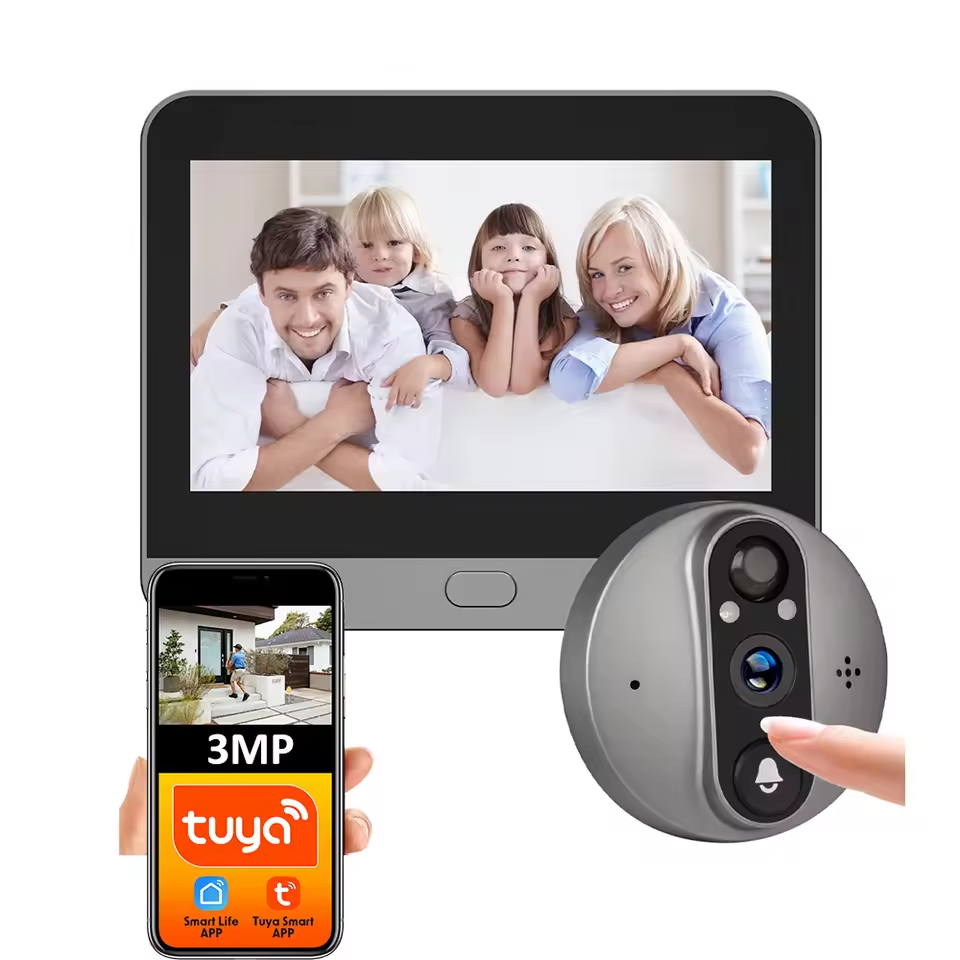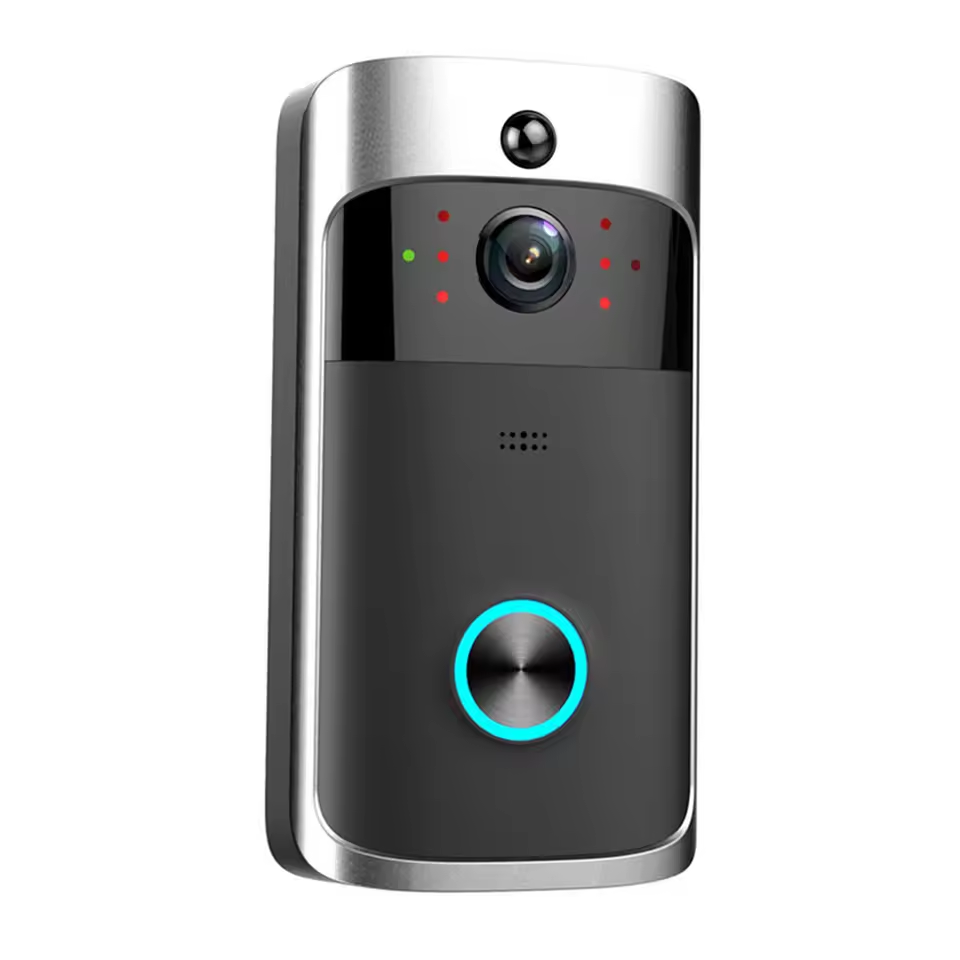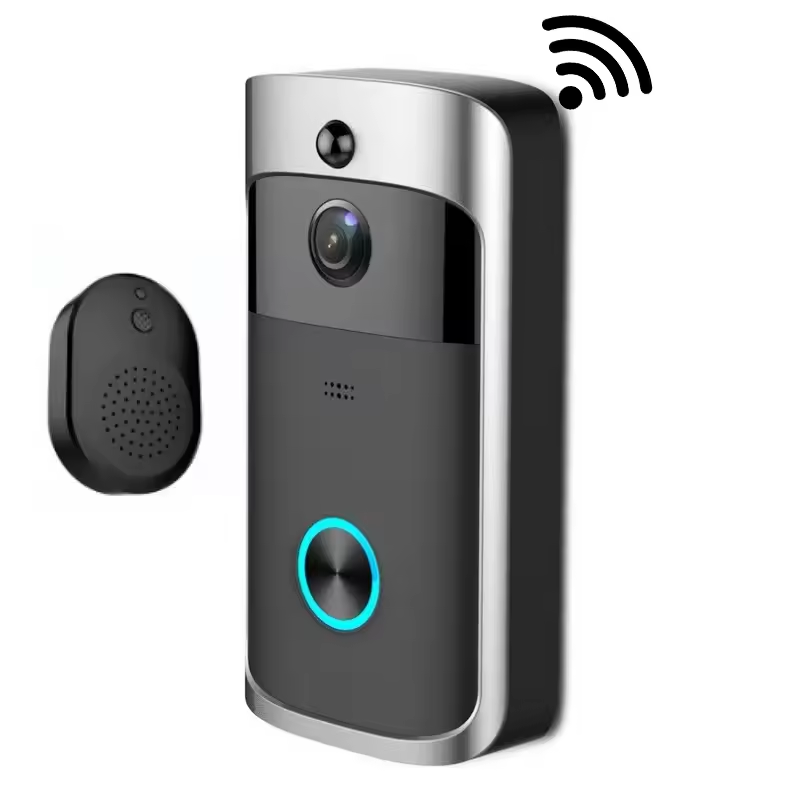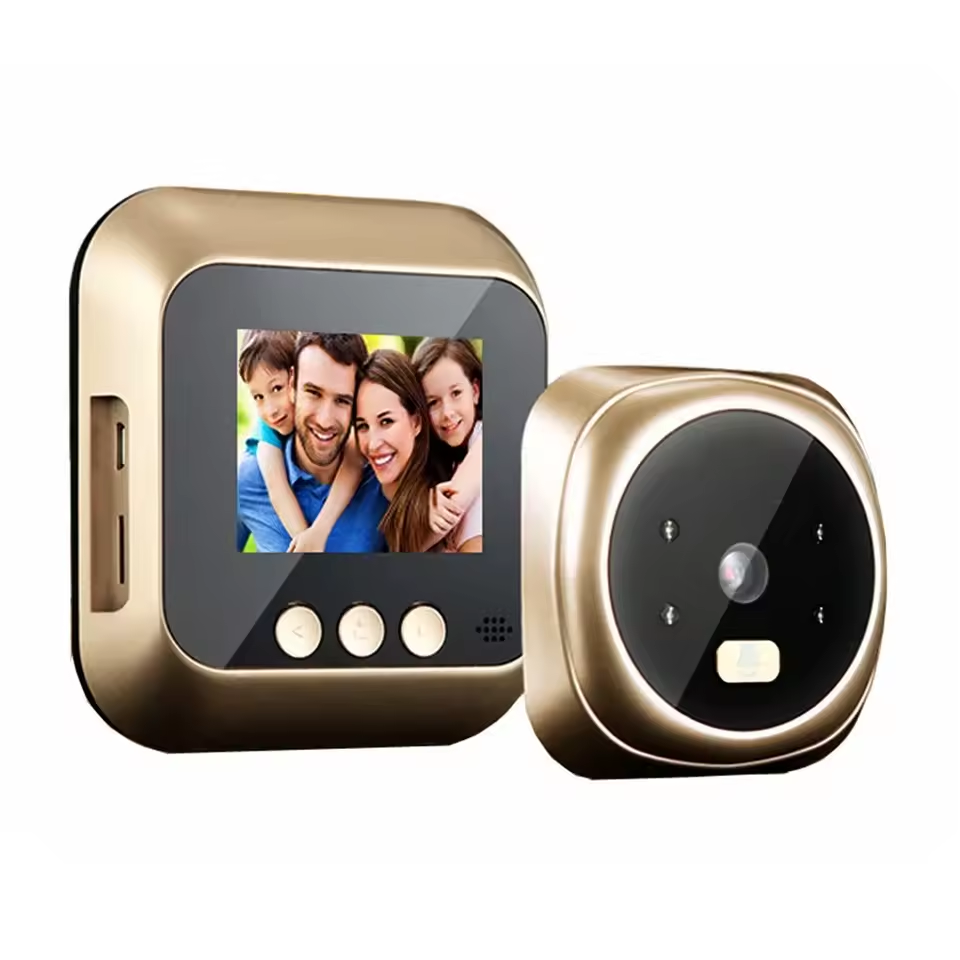What Is a Doorbell Camera Without WiFi?
A doorbell camera without WiFi is a security device. It works independently without needing internet connectivity. Unlike smart doorbell cameras, these operate via local storage or direct connections. They capture video footage and store it on an SD card or a built-in memory unit.

These cameras rely on wired or wireless setups, but not through WiFi. Some use radio frequency (RF) transmitters or cellular networks to send alerts. Others may only display footage on a connected monitor or recording device.
Non-WiFi doorbell cameras are ideal for areas without reliable internet connections. They are also preferred by people who value privacy, as no data is transmitted online. This reduces the risk of hacking or unauthorized access to footage.
In summary, these cameras provide simple yet effective security. They work independently using alternative connectivity methods, combining safety with convenience.
Types of Doorbell Cameras That Don’t Require WiFi
Doorbell camera without WiFi use alternative technology for functionality. They are ideal for ensuring security without the need for internet.
Wired Doorbell Cameras
Wired doorbell cameras connect directly to your existing electrical system. They transmit video footage via cables. These cameras store recordings locally, often on an SD card or a connected DVR system. They are very reliable as they do not face interference or connectivity issues.
Wireless Doorbell Cameras with Local Storage
Wireless non-WiFi doorbell cameras work without internet but use battery power. They often record and save video footage on internal storage or SD cards. These cameras provide flexibility in placement and are easy to install.
Cellular-Connected Doorbell Cameras
Cellular-connected doorbell cameras use SIM cards to operate. They send notifications and video through mobile networks. These cameras are useful in remote locations with poor WiFi availability. Users may need a cellular service plan to maintain functionality.
Radio Frequency (RF) Doorbell Cameras
RF-enabled doorbell cameras use radio signals to operate. They connect to a monitor or receiver placed indoors. These cameras deliver real-time footage and alerts without relying on internet connectivity. They are highly secure and minimize exposure to hacking.
Standalone Doorbell Cameras with Screens
Standalone doorbell cameras come with built-in screens. They display footage directly without connecting to external devices. Users can instantly see who is at the door without requiring additional technology.
Non-WiFi doorbell cameras suit individuals prioritizing privacy and areas with poor internet coverage. Choosing the right type depends on your specific security needs and home setup.
How Do Doorbell Cameras Work Without WiFi?
Doorbell cameras without WiFi operate through alternative methods to capture and display footage. Unlike internet-dependent models, these cameras use other systems to ensure security and functionality. Here’s how they work:
- Local Video Storage: Most non-WiFi doorbell cameras store footage locally. This includes SD cards, hard drives, or built-in memory. The camera saves recordings directly, allowing you to review them later.
- Wired Connections: Some cameras connect to a home electrical system using wires. The wired connection enables stable video transmission to a monitor or recording device. These setups are reliable and avoid wireless interference.
- Battery-Powered Options: Certain models run on batteries. These are ideal for flexible installation without wiring. They store data internally, making them useful in remote areas without power or internet.
- Radio Frequency (RF) Transmission: RF-enabled cameras use radio signals. They transfer video to a compatible monitor or receiver in your home. This method ensures secure and real-time footage.
- Cellular Networks: Cameras with SIM cards use cellular networks for notifications and footage transfer. They work in areas that neither WiFi nor ethernet can serve. A mobile plan is often required for this option.
- Standalone Screens: Some models display video directly on built-in screens. These standalone options let you see visitors immediately without needing any connection.
Doorbell cameras without WiFi focus on offline solutions. Their design combines simple operation and effective security measures. Depending on the setup, these cameras can fit various security needs across different locations.
Benefits of Non-WiFi Doorbell Cameras
Non-WiFi doorbell cameras offer distinct advantages that make them appealing to various users. These devices prioritize security and provide functionality in areas with limited internet access. Below are the key benefits:
Enhanced Privacy
Non-WiFi doorbell cameras do not connect to the internet. This prevents data transmission online. Hackers cannot access your footage, ensuring your privacy and safety.
Reliable Performance
These cameras function independently without relying on network connectivity. They are ideal for locations with unstable or no internet service. Wired and locally-stored options avoid connectivity interruptions.
Ease of Use
Non-WiFi models are simple to set up and operate. Since there’s no need for internet, users avoid complex configurations or software updates. They offer a straightforward security solution for busy households.
Cost Savings
Without the need for internet subscriptions or service plans, users save money. Cellular models may require a data plan, but other types eliminate recurring costs.
Adaptability to Remote Locations
Non-WiFi cameras work well in areas without internet infrastructure. Cellular-connected models, battery-powered options, and RF-enabled devices perform effectively in rural or isolated regions.
Real-Time Display Options
Standalone doorbell cameras with built-in screens display video directly. Users can instantly see visitors without additional equipment or apps.
Non-WiFi doorbell cameras combine security with simplicity. Whether for privacy, cost, or functionality, they fill a unique need in modern home security.
Limitations of Non-WiFi Doorbell Cameras
Non-WiFi doorbell cameras provide effective security, but they come with some drawbacks. Understanding these limitations helps in making an informed choice.
Limited Remote Access
Non-WiFi doorbell cameras lack online access. You can’t view footage remotely or receive alerts online. This makes monitoring less convenient when you are away from home.
Smaller Storage Capacity
Most of these cameras use SD cards or internal memory. Storage space is limited compared to cloud-based systems. Frequent manual management of saved footage may be necessary.
Static Viewing Options
These cameras typically connect to a monitor or display unit. Viewing is restricted to a fixed location. You can’t check your doorbell camera from multiple devices.
Lack of Smart Features
Non-WiFi models don’t have AI-based features like motion detection alerts or facial recognition. Advanced capabilities unique to WiFi-enabled cameras are missing.
Cellular Costs for SIM Models
Cellular-enabled cameras need a mobile service plan. This adds recurring costs to maintain functionality. Without a plan, the camera won’t work effectively.
Setup Challenges for Wired Models
Wired non-WiFi cameras require proper electrical installation. This involves extra time and effort and may demand professional assistance.
Limited Integration With Other Systems
These cameras often don’t integrate with smart home devices. You can’t connect them to other automated systems or apps.
Non-WiFi doorbell cameras are a good option for certain setups, but these limitations can impact their convenience and capabilities. Consider these factors carefully before choosing a model.
Features to Look for in Non-WiFi Doorbell Cameras
Non-WiFi doorbell cameras offer unique features that enhance security. Selecting the right model is essential.
Local Storage Options
Choose a camera with sufficient storage capacity for video recordings. SD cards and internal memory are common options.
Connectivity Type
Verify the connectivity method that suits your setup. Wired, RF, or cellular-connected are popular choices.
Resolution and Image Quality
High-resolution video ensures clear images. Look for models with HD or higher resolution capabilities.
Battery Life or Power Source
For wireless models, check battery life. Ensure wired cameras match your electrical system.
Durability and Weatherproofing
Pick cameras with robust designs. Weatherproof models last longer in outdoor conditions.
Real-Time Monitoring
Ensure the camera supports instant video display. Standalone screens work well for direct viewing.
Easy Installation
Select cameras that are simple to set up. Wireless models offer hassle-free installation options.
Cost Efficiency
Evaluate budget-friendly models without recurring costs. Avoid features you don’t need.
Privacy and Security Features
Ensure your camera prioritizes privacy. Non-WiFi options prevent data breaches and hacking attempts.
Compatibility with Existing Systems
Check if the camera integrates with your current security or monitoring systems, if needed.
Focusing on these features helps you choose the perfect non-WiFi doorbell camera for your needs.
Popular Alternatives to WiFi-Enabled Doorbell Cameras
Non-WiFi doorbell cameras are ideal for areas with no reliable internet. They provide security without data dependency. Let’s explore popular alternatives to WiFi-enabled doorbell cameras that offer robust functionality.
Wired Doorbell Cameras
Wired cameras connect directly to your home’s electrical system. They transmit video through wired connections. Storage is handled via a DVR or SD card. These are stable and reliable for consistent performance.
Standalone Cameras with Screens
Standalone doorbell cameras come equipped with built-in screens. They let you view visitors directly. These models eliminate the need for monitors or apps. They offer instant feedback for added convenience.
Battery-Operated Non-WiFi Solutions
Battery-powered options provide flexibility in installation. They store video locally on internal storage. These are great for temporary setups or locations inaccessible to electric wiring.
Radio Frequency (RF) Cameras
RF-enabled cameras transmit video signals to indoor receivers. These cameras don’t need internet or mobile networks. They ensure secure and real-time footage transmission.
Cellular-Connected Doorbell Cameras
Cellular-enabled cameras use SIM cards for mobile connectivity. They are effective in remote areas. Footage and notifications are sent via mobile networks but require a data plan.
Analog Doorbell Cameras
Analog cameras use traditional CCTV technology. They connect via coaxial cables to recording systems. They are well-suited for users seeking a tested and reliable solution.
Peephole Cameras
Peephole cameras replace traditional door peepholes. They capture video and display it on a built-in screen. These are easy to install and don’t rely on internet access.
Solar-Powered Cameras
Solar-powered options cater to eco-conscious users. They are ideal for outdoor use in sunny locations. These cameras often include local storage and don’t need internet.
Each alternative meets specific needs and preferences. Whether for privacy, cost-saving, or adaptability, non-WiFi options support dependable home security.
How to Install and Maintain a Non-WiFi Doorbell Camera
Installation Steps
- Choose the Location: Pick a spot with clear visibility of your front door.
- Check Compatibility: Ensure the camera suits your electrical system or has battery power.
- Prepare Tools: Gather necessary tools like screws, drills, and mounting brackets.
- Mount the Camera: Secure the camera on the wall using its bracket and screws.
- Connect Wiring: For wired models, properly link the camera to your electrical system.
- Insert Storage Device: If using an SD card, insert it into the camera as per instructions.
- Test Functionality: Confirm that the camera captures video and displays footage correctly.
- Sync Cellular Models: Set up a SIM card and ensure cellular network connection if needed.
Maintenance Tips
- Regular Cleaning: Wipe the lens to maintain clear video quality.
- Check Storage: Ensure the SD card or memory unit has enough space for recordings.
- Inspect Batteries: Replace batteries in wireless models to avoid downtime.
- Monitor Wiring: Periodically check for damage in wired setups to maintain reliable operation.
- Update Firmware: Use manufacturer updates for cellular-connected models to improve security.
- Secure Mounting: Tighten any loose screws to keep the camera stable.
- Shield Against Weather: Use protective covers for cameras exposed to harsh elements.
- Test Functionality: Regularly test video capture and display for early issue detection.
Installing and maintaining a non-WiFi doorbell camera ensures effective and long-lasting security.

